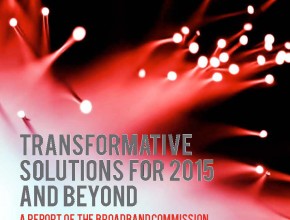
Transformative solutions for 2015 and beyond
As well as continuing to drive progress against the Millennium Development Goals (MDGs) to 2015 and...
Across the information and communication technology (ICT) sector, companies are responding to the climate crisis and rising greenhouse gas (GHGs) emissions. ICT companies are committing to reduce not only their own GHGs, but also the emissions resulting from their value chain, including their supply chain and customers.Many companies are linking their commitments to the Science-Based Target Targets initiative [SBTi] and having them validated as Science-Based Targets (SBTs). For this, an accurate assessment of GHGs is essential to understanding and achieving SBTs. Two types of SBT’s exist: long-term net zero targets and interim targets. More specifically, ITU-T, GeSI and the GSMA have previously established a 1.5 ̊C aligned decarbonisation trajectory for the ICT sector that requires a reduction of 45% between 2020 and 2030 ITU-T L.14701 [SBTi]. ITU-T L.14712 provides further guidance for further reductions to achieve net zero.
Reporting Standards
The most widely used framework for establishing inventories of GHG emissions of companies is the Greenhouse Gas Protocol (GHGP) [GHGP-1], and many companies have been publishing the outcome of their inventories for many years. In addition, the guidance from the International Standardization Organization is given in ISO 14064-1: 20183, and national authorities provide guidance, e.g. the Bilans GES site4in France. Referring to organisations and companies in the ICT sector, ITU-T L.14205gives specific guidance. However, current methodologies/guidelines for value chain reporting do not give enough practical guidance. Historically, this type of reporting has been seen as a voluntary add-on, but it has now become part of expected mainstream GHG reporting.
Scope 3 Emissions
Current reporting of a company’s own emissions (referred to as Scope 1 and 2) is often comprehensive. However, the inventory of value chain emissions (referred to as Scope 3) is more difficult, since this refers to emission sources outside the company’s direct control, and this reporting is less complete than reporting of a company’s own emissions. There is also substantial variation in reporting by ICT companies of Scope 3 with respect to coverage and transparency, making it hard to derive any trends. In particular, it is hard to make any generalised conclusions regarding the distribution of emissions between Scope 1, 2 and 3, let alone between Scope 3 Categories.
Also, the variation between electricity mixes in different markets has a great impact on the distribution of emissions. Many ICT companies are active in several countries while data is presented at a company level making it even harder to understand the relative magnitude of Scope 2 and 3. However, while the ratio between Scope 1, 2 and 3 emissions is supposed to vary across ICT operators, Scope 3 emissions often represent those that are the most substantial.
This guidance harmonises methods for telecommunication operators to assess and report their Scope 3 GHG emissions, and to increase its coverage, and transparency. Based on criteria including association with the portfolios, control and complexity of reporting, this guidance prioritises Categories 1 to 2 and 11 (which addresses the life cycle impact of company portfolios) in particular and Category 3 (which is closely linked to Scope 1 and 2), although all Categories are addressed.
This guidance is intended to supplement, not supersede, existing standards. Thus, different parts present various levels of detailed guidance, as needed. Telecommunication operators wanting to claim conformity to other standards would need to consult them and cannot refer solely to this guidance.

As well as continuing to drive progress against the Millennium Development Goals (MDGs) to 2015 and...

The purpose of this report is to provide practical support to practitioners who are calculating the...